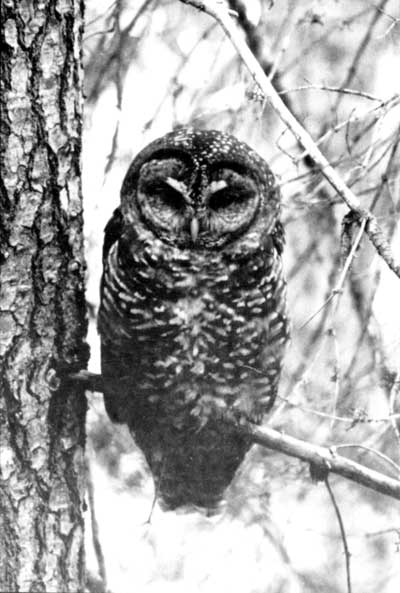|
Volume XXIV - 1993
Spotted Owl Survey
By Lori Stonum
The northern spotted owl (Strix occidentalis caurina) is one
of three subspecies of spotted owls. It is a medium-sized forest owl
distinguished by its large brown eyes and mottled brown and white
breast. The spotted owl is a monogamous, long-lived species, that is
mostly nocturnal. Ranging from southern British Columbia to northern
California, it is found on the east and west slopes of the Cascade Range
and on the Olympic Peninsula. Spotted owls live mostly in low elevation
coniferous old growth forests and have a limited seasonal migration.
The first recorded observation of a spotted owl at Crater Lake
National Park was in 1934. Between 1934 and 1978, there were several
other sightings reported. The first surveys of the spotted owl at the
park were conducted in 1978 in cooperation with the Oregon Department of
Fish and Wildlife and the U.S. Forest Service. Sporadic studies have
been conducted since then, but a complete census was never conducted.
Until 1986, studies within the park concentrated on the west side of the
Cascade Range. When the surveying resumed in 1990, the southern portion
of the park was included. The 1990 and 1991 surveys, however, consisted
only of two-day projects with limited coverage of the park's spotted owl
habitat.
A more comprehensive survey of the northern spotted owl at Crater
Lake National Park commenced in May 1992. This was the first year that a
study of spotted owls in the park was conducted according to standard
protocol. Survey sites were determined based on historic spotted owl
sites, areas of good habitat, and the location of proposed construction
within the park. Since the survey was started late in the season
compared to others in the region, we concentrated on historic owl sites
and future construction zones, making them our priority. New sites were
added as time became available.
Overall, the number of owls found at Crater Lake in 1992 was
unexpected. We now know that the park holds greater significance for
spotted owls than previously thought. During the 1990 and 1991 surveys,
two pairs and one single male spotted owl were found each year. By the
end of the 1992 field season, we had located seven pairs of spotted
owls. Six of the seven pairs had two juveniles. Three single owls of
unknown reproductive status were also found, making a total of 29 owls
found in the park. Of these, 12 owls were banded with the help of the
Oregon Department of Fish and Wildlife so that the owls can be
identified in future studies.
The 1992 spotted owl survey produced two significant findings. One
was the large number of owls located on the east side of the Cascade
Range. Four pairs of spotted owls found in the park this year were on
the east side of the Cascades, which was somewhat unexpected when
considering that most spotted owls are found west of the mountains. The
second finding was the relatively high elevation at which several owl
pairs were living. For two years in a row, Crater Lake National Park has
held the state record for the highest elevation at which a spotted owl
pair was found. The Annie Creek site was the 1991 state record at 1829
meters (6000 ft.), and in 1992 it was the Crater Peak site at 1996
meters (6550 feet). In future studies we hope to be able to focus on
these east side and high elevation sites to determine if there are
factors influencing the owl's range and reproductive status, as compared
to west side and lower elevation sites.
There is still a lot of work to be done in the park on spotted owls.
Less than 30 percent of the 50,000 acres of spotted owl habitat existing
within Crater Lake National Park was surveyed. Considering the exciting
results of the 1992 survey, the potential for even greater numbers of
owls existing within the park is very high. If the spotted owl program
at Crater Lake can continue to expand and survey more of the suitable
habitat, perhaps the complete status of the spotted owls at Crater Lake
could be better known.

| 
